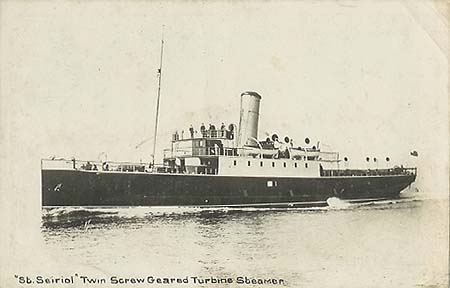|
Feb 18, 1890
|
Born in Folkestone, England
|
|
Nov 6, 1914
|
Attested into the 21st Battalion in Kingston, Ontario
Ø Number 59825 (temporary number 802)
Ø Next of kin given as C Reed, uncle, 32 Mead Rd., Folkestone,
England
Ø Previous occupation given as Labourer
Ø No previous military experience given
Ø Religion given as Church of England
Ø Posted to “G” Company
o This was later reorganized into “D” Company
The 21st Battalion trained in the Kingston, Ontario
area through the winter of 1914-15.
|
|
Feb 1, 1915
|
Appointed to the provisional rank of Lance
Corporal without pay
|
|
May 6, 1915
|
Embarked the RMS Metagama in Montreal, Quebec

|
|
May 15, 1915
|
Disembarked in Devonport, England and the
battalion proceeded to the West Sandling Camp, near Hythe, Kent to continue
training
To draw pay for rank of Lance Corporal
|
|
Jul 1, 1915
|
Confirmed in rank of Lance Corporal
|
|
Sep 1, 1915
|
Promoted to the rank of Corporal
|
|
Sep 14, 1915
|
Embarked the St. Seiriol in Folkestone

|
|
Sep 15, 1915
|
Disembarked in Boulogne, France and the battalion
proceeded to St. Omer
|
|
Nov 14, 1915
|
Proceeded on Bombing Course
|
|
Nov 21, 1915
|
Rejoined the 21st Battalion in the
front line near Voormezeele, Belgium from course
|
|
Dec 8, 1915
|
Admitted to the No. 5 CFA (Canadian Field
Ambulance) with a diagnosis that reads Influenza. Transferred the same day to the Division
Rest Station at the No. 6 Canadian Field Ambulance in Loker, Belgium
|
|
Dec 14, 1915
|
Transferred to the North Midlands Casualty
Clearing Station at Mont des Cats, France
|
|
Dec 18, 1915
|
Discharged from the casualty clearing station and
reported to the base depot
|
|
Dec 21, 1915
|
After leaving the base depot, Corporal Reed rejoined the 21st
Battalion at the front near Voormezeele, Belgium
|
|
Mar 5, 1916
|
Appointed to the rank of Lance Sergeant
|
|
May 22, 1916
|
Granted 9 days leave
|
|
May 31, 1916
|
Rejoined the battalion resting in the “A” Camp
near Dikkebus, Belgium from leave
|
|
Jun 6, 1916
|
Admitted to the No. 5 Canadian Field Ambulance
with a diagnosis that reads Myalgia in his back
|
|
Jun 7, 1916
|
Transferred to the No. 4 Canadian Field Ambulance
|
|
Jun 8, 1916
|
Transferred to the 2nd Division Rest
Station
|
|
Jun 14, 1916
|
Transferred to the No. 12 Casualty Clearing
Station
|
|
Jul 8, 1916
|
Discharged from hospital care and rejoined the 21st
Battalion resting in the Chippawa Camp near La Clytte, Belgium
|
|
Jul 9, 1916
|
Promoted to the rank of Sergeant
|
|
Sep 15, 1916
|
During the 21st Battalion’s capture of
the heavily fortified sugar factory south of Courcelette, France, Sergeant
Reed received a shrapnel wound to his right heel and he was evacuated to a
casualty clearing station where the shrapnel was removed
|
|
Sep 16, 1916
|
Transferred to the No. 18 General Hospital in
Camiers, France
|
|
Sep 26, 1916
|
Invalided to England aboard the Hospital Ship
Stad Antwerpen

On arrival in England, he was admitted to the
Brook War Hospital in Woolwich
Transferred to the CCAC (Canadian Casualty
Assembly Centre) for pay purposes while in hospital
|
|
Oct 9, 1916
|
Transferred to the Hillingdon House Canadian
Convalescent Hospital Woodcote Park, Epsom
|
|
Jan 9, 1917
|
Attached to the 3rd CCD (Canadian
Command Depot) for physical training at the St. Leonard’s Hospital in
Stonehaven, Scotland
|
|
Mar 10, 1917
|
Transferred to the EORD (Eastern Ontario
Regimental Depot) and remained attached to the 3rd Canadian
Command Depot for physical training at St. Leonard’s Hospital
|
|
Jul 5, 1917
|
Discharged from St. Leonard’s Hospital and
transferred to the 6th Reserve Battalion in Seaford
|
|
Nov 5, 1917
|
Admitted to the No. 14 Canadian General Hospital
in Eastbourne with a diagnosis that reads Inflamed Larynx. VDS (Venereal Disease Syphilis) was later
added to the diagnosis
|
|
Nov 16, 1917
|
Transferred to the Canadian Military Hospital in
Etchinghill
|
|
Dec 12, 1917
|
Discharged to duty with the 6th
Reserve Battalion in Seaford from hospital
|
|
Dec 20, 1917
|
To be treated for his Syphilis infection as an
out patient of the 13th Canadian General Hospital in Hastings
|
|
Jun 23, 1919
|
Attached to the CMGD (Canadian Machine Gun Depot)
in Seaford
|
|
Jun 26, 1919
|
Medical Board in Seaford recommends he be discharged
from service as he suffers from persistent symptoms of Syphilis and requires
Mercury treatment
|
|
Jul 11, 1919
|
Discharged from the CEF at the No. 2 Canadian
Discharge Depot, London, England
Ø Rank on discharge Sergeant
Ø Entitled to War Service Badge
Class “A”
Ø Proposed residence on
discharge 32 Mead Rd., Folkestone, England
Following his discharge, the 1914-15 Star,
British War Medal and Victory Medals were sent to him at 32 Mead Rd.,
Folkestone, England
|
|